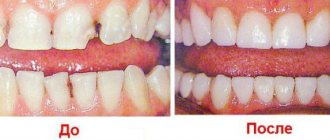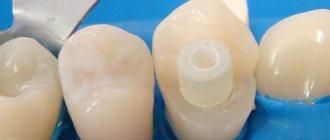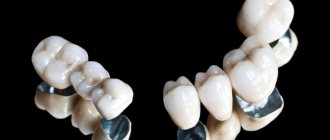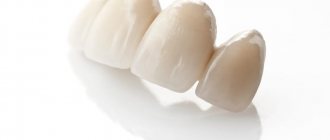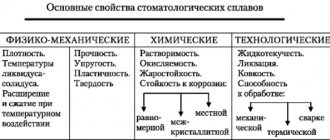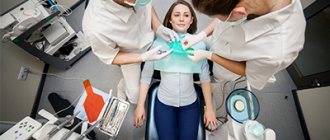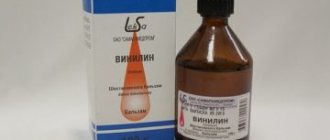Indications and contraindications for tooth augmentation
Teeth augmentation is a multi-stage technology for restoring the aesthetic appearance and functions of the jaw, which was susceptible to chipping or erased as a result of increased tone of the masticatory muscles, called buxism.
Indications for the tooth augmentation procedure:
- chips resulting from injuries;
- numerous caries lesions;
- large distance between teeth;
- wedge-shaped defect;
- the presence of a gap between the two front teeth;
- congenital structural pathologies;
- thinning and demineralization of enamel due to consumption of junk food and lack of oral hygiene;
- cervical caries;
- the presence of errors in previous dental sessions that resulted in the destruction of healthy tissue;
- malocclusion.
Having asked the dentist a question about what tooth extension is called, the patient will immediately hear the answer. The procedure is called dentition restoration. Modern extension technologies make it possible to restore the structure in most cases without resorting to its removal. The procedure is harmless, but has a number of contraindications:
- patient age – more than 60 years;
- children's age when using pins;
- presence of a cyst;
- inflammation of the gums;
- pregnancy in the first or third trimester;
- failure to comply with personal hygiene rules;
- periodontitis and stomatitis;
- jaw fracture and other injuries.
If a patient is diagnosed with diseases that are contraindications, the dentist first treats them, and then restores the dentition.
In what cases is extension applied?
Despite the fact that tooth tissues have high density and strength, they can be destroyed for various reasons.
Firstly, pulpless teeth are often subject to destruction. Once the nerves are removed, they are no longer supplied with nutrition, their tissues demineralize and become fragile. Fragments can break off from the edges or chewing surface, and subsequently the teeth can become significantly damaged.
Secondly, teeth can be severely damaged from sports or household trauma, from chewing or biting off very hard food. In such cases, small chips of the edges, chewing surfaces, and cracks are common [2]. Children's front teeth often suffer due to accidental injuries.
In these cases, tooth augmentation helps restore the lost part of a broken tooth, in which the missing fragments are molded by a specialist from a composite material [2]. Front teeth augmentation is also successfully used in pediatric dentistry, where, thanks to modern materials and methods, pediatric specialists are able to restore a damaged tooth, which reliably serves the little patient until it is replaced with a permanent one.
Some dental procedures may expose the root. In this case, extensions help cover the sensitive area.
In addition, the extension procedure is also used in aesthetic dentistry to eliminate certain defects. Among them [3].
- difference due to anatomical and physiological characteristics of the shape, size, length of an individual tooth in a row;
- difference in tooth color;
- the presence of large interdental spaces;
- defects in the closure of the dentition.
Dental bonding is the most appropriate way to restore chipped teeth
“The 8 Best Ways to Improve Your Smile” American Dental Association
Teeth extension methods
There are 2 main extension methods:
- Straight. Used if tooth decay is up to 30%. During the procedure, composite or photopolymer materials are used to build teeth. The former are less durable and harden after 30 minutes. The latter have a service life of 10 years and remain plastic until exposed to the lamp.
- Indirect. Applicable when damage affects no more than 70% of the structure. The method has several stages, including taking impressions, making and installing ceramic inlays.
If you have ever thought about whether a crown or extension is better, then you should know that a crown is installed when more than 70% of the tissue is destroyed, but a intact and healthy root remains.
What is extension
Tooth augmentation is a dental procedure that involves restoring the lost crown using special dental composite materials. This manipulation is used to solve therapeutic and aesthetic problems in both adult and pediatric dentistry. It is quite popular due to its relative speed and cost-effectiveness, especially in comparison with more complex and invasive procedures such as the installation of crowns or veneers [1].
Features of front teeth extensions
Restoration of anterior teeth is carried out in the following cases:
- Yellowing of enamel;
- Damage to caries;
- Minor curvature;
- Presence of chips or chips;
- Grayish-yellow coating.
Composites and photopolymers are used for extensions, but veneers are the most popular. They are used for minor damage to healthy tissue. If the tooth body is deeply damaged, it is removed from the roots and an implant is implanted in its place. Types of veneers presented in our clinic: composite veneers, ceramic veneers.
Chips of baby teeth often occur in childhood. Many parents do not pay attention to this, hoping for the speedy growth of indigenous children. This is wrong, as the sharp edges scratch the tongue, causing inflammation and infection. Children's extensions are made using composite materials and are absolutely painless.
Preparing to restore teeth using extensions
- Make an appointment with a dentist to decide on an option for restoring a tooth or several teeth.
- The specialist uses a composite scale to determine the natural shade of your teeth and select the required color for a filling or crown.
- It is imperative to do an X-ray examination of the roots and canals of the teeth to exclude pathological processes and, if necessary, prescribe treatment.
- If you want to achieve impeccable aesthetics, before adding teeth, the remaining teeth are whitened, and the color and transparency of the new tooth (which is being restored) is matched to the rest.
- If you have dental caries or gum disease, they must be treated. Only treated and thoroughly examined dental units can be restored!
- Preventive teeth cleaning and removal of hard and soft plaque are performed.
Tooth extension onto a pin
When thinking about whether it is possible to build a tooth onto the root, the use of a pin comes to mind. It is used if both the body and the root are severely damaged.
The procedure includes:
- obtaining an x-ray;
- cleaning the mouth, removing stones;
- removal of damaged areas;
- computer tooth modeling;
- removal of saliva;
- anesthesia;
- cleaning of channels;
- implantation of a pin, cleansing the area around it;
- filling the space around the pin with a composite or photopolymer;
- polishing and grinding.
Dentists build up teeth under crowns only if the remainder is in good condition and does not rot or decompose.
Pros and cons of extensions
The objective advantages of artistic restoration include:
- safety (the method is suitable even for children),
- possibility of restoration even with significant chips,
- high degree of strength of the extended part,
- natural appearance.
As for the disadvantages, these include the comparative high cost. Despite the variety of methods and price categories, most often this procedure is not cheap.
Another disadvantage is that to ensure safe conditions for the restored area, it becomes necessary to wear a mouth guard during sleep.
Does it hurt to grow teeth?
Tooth extension is a painless procedure. Anesthesia is not performed if the damage is not significant, since manipulations are carried out at a superficial level. If the damage is severe, the dentist administers local anesthesia. Modern drugs begin to act immediately after administration.
After the session, the first day you may experience pain if the canals were cleaned. Painkillers will help you feel better.
The restored dentition will last a long time if the patient provides proper care. If the question arises about whether it is possible to smoke after tooth extensions, the answer will be negative. Composite and photopolymer materials quickly absorb all substances, which is why the filling quickly changes color. Maintaining hygiene and regular visits to the dentist will help you maintain your smile for a long time.
Need for expansion
The question of the advisability of this operation can hardly be classified as controversial. With the exception of a number of contraindications (which will be discussed a little later in the corresponding section of this review), the decision to grow teeth turns out to be truly correct from both an aesthetic and functional point of view.
The technology currently used allows for prompt and high-quality restoration of worn teeth, as well as completely eliminating the consequences of chipping. And if for the rear, hidden from prying eyes, units of the dentition, the main parameters are reliability and practicality, then the front row, which is in plain sight, should also have excellent presentability. Fortunately, today all these problems are completely solvable.
For the restoration of primarily molars, a composite material is often used, which in its physical, safe and aesthetic properties is as close as possible to the natural original. As a result of the restoration, the incisors and molars are completely restored to their original natural shape and color.
How long does dental prosthetics take?
Stages of dental prosthetics
Timing of dental prosthetics
What to do after prosthetics?
Today, dentists are ready to offer various options for smile restoration - implantation, inlays, crowns, bridges, removable/fixed dentures, veneers. Prosthetics are done for various reasons, but many are interested in the question: how long does dental prosthetics take?
When they come to him
There are certain indications and contraindications for tooth augmentation. The dentist recommends extensions in the following cases:
- a small part of the tooth was lost due to caries;
- tooth enamel wears off over time and becomes very thin;
- malocclusion;
- trauma to a tooth or teeth, as a result of which the integrity was compromised;
- the appearance of interdental gaps;
- discoloration of teeth that cannot be corrected even with brushing or whitening (advanced form of fluorosis);
- cracked enamel, presence of other mechanical damage;
- chipped tooth.
Pin installation
One of the best inventions in dentistry is, of course, teeth extensions. Thanks to this procedure, patients have the opportunity to eliminate various aesthetic problems, which are most often associated with damage to the front row of teeth in the so-called smile zone.
Teeth extension - photo
What to do after prosthetics?
Caring for fixed orthopedic structures is no different from caring for your own teeth: brush your teeth morning and evening, and rinse your mouth after every meal. If the design is removable and you do not use gel for fixation, then do not forget to wash it after eating. If the removable denture is fixed on the gel, then it is enough to rinse your mouth. Also, twice a week, removable dentures must be cleaned using special tablets. Your doctor will give you a complete list of recommendations.
Disadvantages of augmented teeth
One of the main disadvantages of restorations is their tendency to darken and lose shine over time. Fillings and restorations made from light-polymer filling materials, unfortunately, tend to gradually darken. If on the chewing teeth, located in the depths of the oral cavity, darkening is not noticeable, then on the front teeth this fact becomes obvious. Therefore, restorations require dynamic monitoring, polishing and timely replacement.
The next one is the risk of chipping the restorations. When restoration is performed on a pulpless tooth that has decayed by more than ½, the risk of its breakage is quite high. This is due to the fact that, in some cases, pulpless teeth are more fragile compared to living ones.
Especially often, specialists are faced with a chip of a previously restored tooth when the entire crown of the tooth has been restored. Part of the tooth may break off if the chewing load sharply exceeds the strength limit of the restored structure. Sometimes this causes a fracture of its root.
How much does the procedure cost?
For a complete restoration of a damaged tooth, you will have to pay at least 5,000 rubles. This includes the use of painkillers (200-300 rubles), consumables that isolate the damaged tooth from saliva (approximately 400 rubles). Also, do not forget about sterilizing the set of instruments used - the cost is low, about 100 rubles, but still people often do not take this into account. The main amount spent is spent on the purchase of filling materials, which are used to build up the tooth. This is around 3000 rubles. Also, the use of technology using a pin implies the purchase of an imported product, which also costs a lot. Prices may vary depending on the clinic where the procedure is performed.
Tooth restoration using a fiberglass pin
You can save a lot by using a domestic fiberglass pin, the cost of which is 60-100 rubles. But, as a rule, they do a poor job of fixing the tooth in the root canal.
The cost of tooth augmentation may vary
Regardless of the chosen extension method or materials, the main thing is not the procedure itself, but the subsequent care. After all, what is the point of an expensive procedure if, after installing an artificial tooth, the patient does not follow the rules of oral hygiene? The main thing is to follow the doctor’s recommendations and do not forget that caring for the extended tooth affects its service life. Therefore, it (care) should not be less thorough than caring for living teeth.

